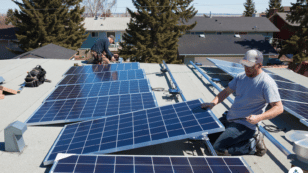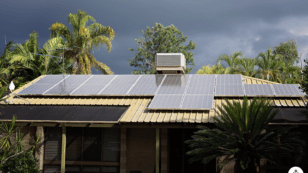

The Science Behind How Solar Panels Work?
Here’s what we’ll cover in this guide:
- How do solar panels work, step-by-step?
- How do solar panels work at night and during rain?
- How do solar panels work with your power grid?
Each product and or company featured here has been independently selected by the writer. You can learn more about our review methodology here. If you make a purchase using the links included, we may earn commission.
How Do Solar Panels Work?
When you purchase solar panels, your installer will position several panels on the roof of your home in what’s called a solar array. The specific number of solar panels you require depends on several factors, including the size and position of your roof, the amount of sunlight your home receives, and the type of solar panels you select.
Solar panels use photovoltaic cells, or PV cells, to absorb light from the sun. (More on the photovoltaic effect in just a moment.) When sunlight hits the panels, they generate a direct current, or DC electricity. However, homes require alternating current, or AC electricity.
A device called a solar panel inverter is a key part of the solar energy system, as it converts the electric current from DC to AC. The AC power then circulates through your household electrical panel and is distributed as needed to your different systems, appliances and outlets. Here’s a quick, step-by-step summary of how solar panels work to power your home:
- Photovoltaic cells absorb sunlight, and use it to generate DC energy.
- An inverter turns the DC energy into AC energy, which is what your household electrical system requires.
- Electricity is distributed throughout your home, powering outlets and appliances.
- Any excess or leftover electricity that is produced is fed into a battery bank or back to your local power grid.
More From EcoWatch: What Is Solar Energy?

Blue Raven Solar

Regional Service
Average cost
Pros
- Industry-leading in-house financing
- Competitive pricing
- Excellent reputation
Cons
- Doesn't offer solar batteries (coming 2022)
SunPower designs and installs industry-leading residential solar and storage solutions across all 50 states. With a storied history of innovation dating back to 1985, no other company on this list can match SunPower’s experience and expertise.
SunPower earns its position as the top national installer on our list for a handful of reasons: It installs the most efficient solar technology on the residential market, offers the most expansive service area and backs its installations with a warranty well above the industry standard. All the while, SunPower pioneers sustainability efforts within the industry.
If that weren’t enough, SunPower systems come packaged with products all manufactured in-house by its sister company, Maxeon. This means that your panels, solar cells, inverters, battery and EV chargers are designed to work together and are all covered under the same warranty.
SunPower’s biggest downside? Its high-efficiency panels are considerably more expensive than most of its competitors’ products. However, its powerful panels are workhorses that make up for the initial cost with more backend production (think about this like spending more money for a car that gets more miles per gallon).
Facts and Figures: Blue Raven Solar
| EcoWatch Rating |
|---|
| Better Business Bureau (BBB) Rating |
| Year Founded |
| Average Cost ($-$$$$$) |
| Solar Services |
| Brands of Solar Equipment Offered |
| Warranty Coverage |
| 4.5 |
| A+ |
| 2014 |
| $$ |
| Solar Panels, System Monitoring |
| Trina Solar, Canadian Solar, SolarEdge, Silfab, SunPower |
| 25-year manufacturer warranty; 10-year workmanship warranty, 2-year production guarantee |

Blue Raven Solar

Regional Service
Average cost
Pros
- Industry-leading in-house financing
- Competitive pricing
- Excellent reputation
Cons
- Doesn't offer solar batteries (coming 2022)
We like Blue Raven Solar because it understands that, for most homeowners, the cost of solar presents the biggest barrier to entry.
For that reason, Blue Raven Solar developed an innovative solar financing plan that offers in-house, flexible, zero-money-down options. The results speak for themselves, as Blue Raven Solar is now one of the fastest-growing solar companies in the nation and was recently acquired by SunPower. Its BluePower Plus+ plan (exclusive to Blue Raven) mimics the flexible structure of a lease while still providing the greatest benefits of owning your system.
Eligible homeowners enjoy 18 months of solar power before having to pay their first bill. When coupled with the federal solar investment tax credit (ITC), the initial energy savings can offset more than a third of the overall cost of a system before requiring a dollar down.
In contrast, other installers can only offer similar financing through solar leases, PPAs or third-party providers (such as Mosaic or Sunlight). Third-party loan providers can complicate the process, while opting for a loan or PPA will disqualify you from some of solar’s biggest benefits (additional property value, federal solar tax credit and local solar incentives).
Facts and Figures: Blue Raven Solar
| EcoWatch Rating |
|---|
| Better Business Bureau (BBB) Rating |
| Year Founded |
| Average Cost ($-$$$$$) |
| Solar Services |
| Brands of Solar Equipment Offered |
| Warranty Coverage |
| 4.5 |
| A+ |
| 2014 |
| $$ |
| Solar Panels, System Monitoring |
| Trina Solar, Canadian Solar, SolarEdge, Silfab, SunPower |
| 25-year manufacturer warranty; 10-year workmanship warranty, 2-year production guarantee |
The Science of Solar Panels: How Panels are Powered and How Panels work
While there are a few types of solar panels to choose from, most household systems work in roughly the same way. There is usually a layer of silicon cells surrounded by a metal frame and a glass case. There are also wires throughout the panel, allowing the free flow of electricity.
You may (or may not) remember from your high school science classes that silicon is a non-metal with conductive properties. In other words, it is able to absorb light and then generate electricity.
How Solar Panels Work is Simple:
When light hits the silicon cells, electrons are set into motion, producing an electrical current. This electricity generation process is known as the photovoltaic effect, and it is one of the core principles of solar technology.
More About the Photovoltaic Effect
Let’s dig into the photovoltaic effect a little deeper. This principle was first discovered way back in 1839 and is generally associated with semiconductor materials.
The photovoltaic effect simply describes the property by which these materials can generate electricity any time they are exposed to sunlight. Here’s a step-by-step summary that explains how solar panels work by employing the photovoltaic effect:
- Sunlight hits the solar panel, which has two layers of silicon, an n-type layer (which is made with phosphorus to make it lose electrons when exposed to sunlight) that sits on top of a p-type layer (made with boron gas to make it accept electrons more readily).
- The sun’s energy knocks an electron from its bond in the upper n-type layer, creating both a freely roaming electron and a positively charged “hole” where the electron was previously bonded.
- The hole travels down to the p-type layer, and the free electron travels through conductive wires to an inverter.
- The inverter transforms the solar electricity from DC to AC so that it can be used in your home.
- The electricity flows throughout your home to power systems, appliances and outlets.
- The free electron eventually flows through the house and back to the p-type layer of the panel, where it fills a positively charged hole and closes the loop needed to maintain the flow of electricity.
To get a free quote from a solar company, click one of the buttons below.
How Solar Panels Work With Your Power Grid or Battery Bank
We mentioned earlier that any excess electricity generated by a solar panel is fed back into a power grid or can be stored in a solar battery. What are these, exactly, and how do solar panels work with each component? If your home is connected to the electrical grid (and most homes are), then it comes with a utility meter.
This meter allows your utility company to measure how much energy you are consuming. During solar panel installation, your solar system will typically be connected to the utility meter. In many cases, your existing meter will be replaced with a bidirectional meter, which, as the name suggests, allows electricity to flow in both directions. Thus, the meter assesses and measures your home’s consumption as well as how it relates to your solar energy production.
Many solar homes produce more energy than they consume. In this case, you can either send your excess energy back to the electrical grid (through a process called net metering), or you can purchase a battery to store your energy for future use.
- Power grid: When you feed energy back into your power grid, you might receive credits from your utility company to save even more money on your monthly bills and help offset the cost of solar panels even when the sun isn’t shining and your panels aren’t producing. Net metering is not available in all states, and the credit rate varies, so make sure to check the net metering policy in your area.
- Battery: The best solar batteries have a high capacity so that you can store enough excess energy to power your home during power outages and on cloudy days. A single Tesla Powerwall, for example, can power the average home in the U.S. for about half a day. With a capacity of 13.1 kWh, an average consumption of 881 kWh per month (or 29 kWh per day), that 13.1 kWh should cover normal electricity consumption for around 12 hours. That could be longer if you reduce consumption or install multiple batteries.
Additional Components of Your Home Solar System
Now that you understand the most important components of your home solar system, there are a couple more items to consider that affect how solar panels work in terms of efficiency. We mentioned above that most solar panels come with a glass casing.
This helps protect the silicon solar cells and ensures the longevity and durability of your home solar system. Beneath that glass case, there may also be some insulating materials, which protect your equipment from humidity as well as from heat dissipation.
This insulation is crucial because it allows the solar panel system to work optimally. A lot of solar panels are coated in anti-reflective materials as well. This is so that they can absorb as much of the sun’s light as possible. Again, this is an important way to keep your home solar system working smoothly and efficiently.
A final note for homeowners who are interested in solar energy: As you select your solar panels, you will generally have a choice between monocrystalline and polycrystalline. Monocrystalline panels are made using a single silicon crystal.
They tend to be the most efficient solar panels — up to 22.8% efficient — though they can also be pricier — sometimes reaching over $4.00 per watt for high-end models.
Polycrystalline solar panels are made up of multiple crystal fragments and usually cost less. They average closer to 18% efficiency but can reach up to around 20%, and they usually cost less — an average of closer to $3 per watt.
Getting Started With Solar Energy
Now that you know how solar panels work, you may feel ready to get going with a home solar system. The first step is identifying the top solar companies in your area and calling an installer to find out if solar panels are worth it for your home. Your installer will conduct an assessment based on the size of your home, the surface area of your roof, the amount of sunlight you get and more.
It will furnish some guidance as to how many solar panels you need and which type of panel is the best bet. Getting a home solar system can be a great way to save money on your monthly utility costs while demonstrating a real commitment to environmental stewardship.
Going solar doesn’t have to mean spending a crazy amount of money upfront, in fact there are so many different ways to finance solar that it is more accessible to get solar technology now more than ever. Solar panels now-a-days have the ability to not only save you money in the long run by lowering your electricity bill (average lifetime net savings of $31,513!), they can also save you money in the short term through federal tax incentives (the federal tax credit alone is worth an average of $8,991).
To get a free quote from a solar company, click one of the buttons below.
The cost information presented in this article is derived from a comprehensive analysis, incorporating data from multiple industry sources. The average cost per watt per state was calculated based on figures from Consumer Affairs, Energy Sage, and Berkeley Lab’s Electricity Markets & Policy Department. Additionally, monthly energy consumption and the average monthly cost of electricity were sourced from the U.S. Energy Information Administration, ensuring a well-rounded and accurate representation of the information presented.
FAQ: How Solar Panels Work
Solar panels work by absorbing solar energy and converting it into usable AC electricity through this process:
- Photovoltaic cells absorb sunlight, then turn it into DC energy.
- An inverter turns the DC energy into AC energy, which is what your household electrical system requires.
- Electricity is distributed throughout your home, powering outlets and appliances.
- Any excess or leftover electricity that is produced is fed into a battery bank or back to your local power grid.
The two main disadvantages of solar panels are that they only generate electricity when the sun is out, and they’re only effective on roofs with proper space and exposure to sunlight. To combat these disadvantages, manufacturers are developing solar batteries that store excess energy generated in daylight hours for use when the sun is down. You might also be surprised by how effective solar panels are on cloudy days.
Further, utility companies are investing in solar farms and community solar to share the benefits of solar with homes unfit for solar panels themselves.
Solar panels do not generate electricity when the sun isn’t shining. However, most solar arrays generate more electricity during peak daylight hours than can be used in a day. Solar batteries are used to store this excess energy for use when the sun isn’t up.
Comparing authorized solar partners
-
- Industry-leading in-house financing
- Competitive pricing
- Excellent reputation
- Doesn't offer solar batteries (coming 2022)
A+Best Solar Financing2014Trina Solar, Canadian Solar, SolarEdge, Silfab, SunPower25-year manufacturer warranty; 10-year workmanship warranty, 2-year production guarantee
Having trouble deciding? Click below and use our process to receive multiple quotes instead:

 233k
233k  41k
41k  Subscribe
Subscribe 







